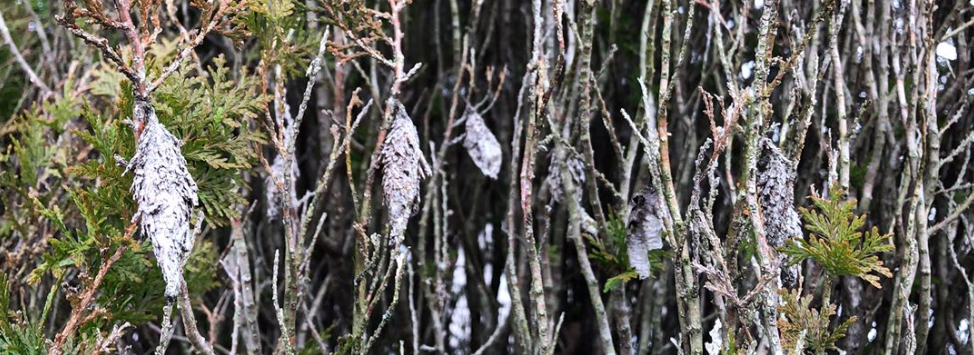Walking in a Winter Wonderland...With Bagworms
I’m not a big fan of winter. It’s just too cold and dark; plus, I like the greenness of spring and summer.
Since I won’t be moving to any subtropical or tropical climates anytime soon, I’ve learned to look for the positives of winter. For example, the first snow fall can be pretty, and I love seeing the arctic swans on the bay on my Sunday morning runs. And I also look forward to being able to easily spot tree damage caused by insects and diseases. Winter is a great opportunity to see all sorts of tree cankers, galls, and wood decay that are normally shrouded by leaves!
Imagine my delight when on my walk through the neighborhood the other day, a large, half dead arborvitae caught my eye…it was positively covered with dozens of ‘bags’ caused by bagworms. There were scads of them!
Bagworms are a type of caterpillar that make a little ‘bag’ out of silk and host plant material as their nest, for both protection and overwintering. The female bagworm remains in a worm-like state and never leaves the bag she constructs until she dies. Females lay eggs in the bag in the fall, and the eggs hatch the following spring. Larvae hang out in the bag all summer, partially emerging from time to time to feed on the host plant. Males, on the other hand, develop into a moth with clear wings that eventually leave the bag in early fall to fly to a bag with a female to mate.
While their bags are quite fascinating, bagworms are a pest capable of inflicting damage to their host plant (evergreens, sycamore, willows, & other deciduous trees…over 128 different plants!) through feeding. The bags are normally difficult to see – they blend in very well with the host plant – and become more obvious during heavy infestations. And the winter.
Control is fairly simple – remove the bags before the eggs hatch in the spring. Just remember to throw the ‘bags’ somewhere outside of your landscape; so that they don’t reenter it. However, insecticides may be needed during heavy infestations.
Dr. Jill Calabro
HRI Science & Research Directo
Photo courtesy J. Calabro, HRI.
Learn more about bagworms in this helpful video from Nebraska Extension Entomologists.
Share This Post







